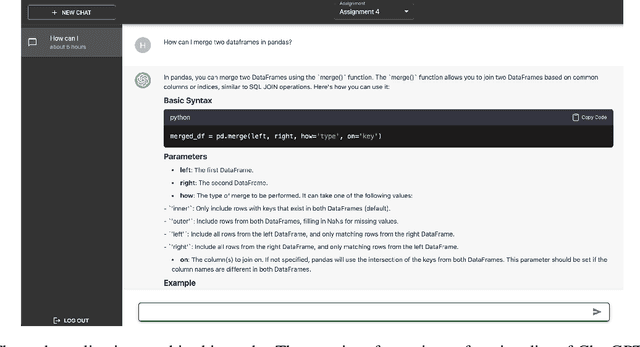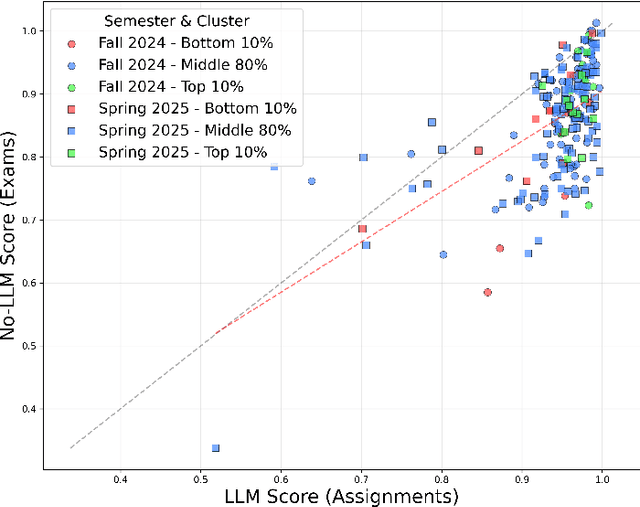Andrew Lan
Exploring LLMs for Predicting Tutor Strategy and Student Outcomes in Dialogues
Jul 09, 2025Abstract:Tutoring dialogues have gained significant attention in recent years, given the prominence of online learning and the emerging tutoring abilities of artificial intelligence (AI) agents powered by large language models (LLMs). Recent studies have shown that the strategies used by tutors can have significant effects on student outcomes, necessitating methods to predict how tutors will behave and how their actions impact students. However, few works have studied predicting tutor strategy in dialogues. Therefore, in this work we investigate the ability of modern LLMs, particularly Llama 3 and GPT-4o, to predict both future tutor moves and student outcomes in dialogues, using two math tutoring dialogue datasets. We find that even state-of-the-art LLMs struggle to predict future tutor strategy while tutor strategy is highly indicative of student outcomes, outlining a need for more powerful methods to approach this task.
LookAlike: Consistent Distractor Generation in Math MCQs
May 03, 2025Abstract:Large language models (LLMs) are increasingly used to generate distractors for multiple-choice questions (MCQs), especially in domains like math education. However, existing approaches are limited in ensuring that the generated distractors are consistent with common student errors. We propose LookAlike, a method that improves error-distractor consistency via preference optimization. Our two main innovations are: (a) mining synthetic preference pairs from model inconsistencies, and (b) alternating supervised fine-tuning (SFT) with Direct Preference Optimization (DPO) to stabilize training. Unlike prior work that relies on heuristics or manually annotated preference data, LookAlike uses its own generation inconsistencies as dispreferred samples, thus enabling scalable and stable training. Evaluated on a real-world dataset of 1,400+ math MCQs, LookAlike achieves 51.6% accuracy in distractor generation and 57.2% in error generation under LLM-as-a-judge evaluation, outperforming an existing state-of-the-art method (45.6% / 47.7%). These improvements highlight the effectiveness of preference-based regularization and inconsistency mining for generating consistent math MCQ distractors at scale.
Reasoning and Sampling-Augmented MCQ Difficulty Prediction via LLMs
Mar 11, 2025



Abstract:The difficulty of multiple-choice questions (MCQs) is a crucial factor for educational assessments. Predicting MCQ difficulty is challenging since it requires understanding both the complexity of reaching the correct option and the plausibility of distractors, i.e., incorrect options. In this paper, we propose a novel, two-stage method to predict the difficulty of MCQs. First, to better estimate the complexity of each MCQ, we use large language models (LLMs) to augment the reasoning steps required to reach each option. We use not just the MCQ itself but also these reasoning steps as input to predict the difficulty. Second, to capture the plausibility of distractors, we sample knowledge levels from a distribution to account for variation among students responding to the MCQ. This setup, inspired by item response theory (IRT), enable us to estimate the likelihood of students selecting each (both correct and incorrect) option. We align these predictions with their ground truth values, using a Kullback-Leibler (KL) divergence-based regularization objective, and use estimated likelihoods to predict MCQ difficulty. We evaluate our method on two real-world \emph{math} MCQ and response datasets with ground truth difficulty values estimated using IRT. Experimental results show that our method outperforms all baselines, up to a 28.3\% reduction in mean squared error and a 34.6\% improvement in the coefficient of determination. We also qualitatively discuss how our novel method results in higher accuracy in predicting MCQ difficulty.
The StudyChat Dataset: Student Dialogues With ChatGPT in an Artificial Intelligence Course
Mar 11, 2025



Abstract:The widespread availability of large language models (LLMs), such as ChatGPT, has significantly impacted education, raising both opportunities and challenges. Students can frequently interact with LLM-powered, interactive learning tools, but their usage patterns need to be analyzed to ensure ethical usage of these tools. To better understand how students interact with LLMs in an academic setting, we introduce \textbf{StudyChat}, a publicly available dataset capturing real-world student interactions with an LLM-powered tutoring chatbot in a semester-long, university-level artificial intelligence (AI) course. We deploy a web application that replicates ChatGPT's core functionalities, and use it to log student interactions with the LLM while working on programming assignments. We collect 1,197 conversations, which we annotate using a dialogue act labeling schema inspired by observed interaction patterns and prior research. Additionally, we analyze these interactions, highlight behavioral trends, and analyze how specific usage patterns relate to course outcomes. \textbf{StudyChat} provides a rich resource for the learning sciences and AI in education communities, enabling further research into the evolving role of LLMs in education.
From Text to Visuals: Using LLMs to Generate Math Diagrams with Vector Graphics
Mar 10, 2025Abstract:Advances in large language models (LLMs) offer new possibilities for enhancing math education by automating support for both teachers and students. While prior work has focused on generating math problems and high-quality distractors, the role of visualization in math learning remains under-explored. Diagrams are essential for mathematical thinking and problem-solving, yet manually creating them is time-consuming and requires domain-specific expertise, limiting scalability. Recent research on using LLMs to generate Scalable Vector Graphics (SVG) presents a promising approach to automating diagram creation. Unlike pixel-based images, SVGs represent geometric figures using XML, allowing seamless scaling and adaptability. Educational platforms such as Khan Academy and IXL already use SVGs to display math problems and hints. In this paper, we explore the use of LLMs to generate math-related diagrams that accompany textual hints via intermediate SVG representations. We address three research questions: (1) how to automatically generate math diagrams in problem-solving hints and evaluate their quality, (2) whether SVG is an effective intermediate representation for math diagrams, and (3) what prompting strategies and formats are required for LLMs to generate accurate SVG-based diagrams. Our contributions include defining the task of automatically generating SVG-based diagrams for math hints, developing an LLM prompting-based pipeline, and identifying key strategies for improving diagram generation. Additionally, we introduce a Visual Question Answering-based evaluation setup and conduct ablation studies to assess different pipeline variations. By automating the math diagram creation, we aim to provide students and teachers with accurate, conceptually relevant visual aids that enhance problem-solving and learning experiences.
Training LLM-based Tutors to Improve Student Learning Outcomes in Dialogues
Mar 09, 2025



Abstract:Generative artificial intelligence (AI) has the potential to scale up personalized tutoring through large language models (LLMs). Recent AI tutors are adapted for the tutoring task by training or prompting LLMs to follow effective pedagogical principles, though they are not trained to maximize student learning throughout the course of a dialogue. Therefore, they may engage with students in a suboptimal way. We address this limitation by introducing an approach to train LLMs to generate tutor utterances that maximize the likelihood of student correctness, while still encouraging the model to follow good pedagogical practice. Specifically, we generate a set of candidate tutor utterances and score them using (1) an LLM-based student model to predict the chance of correct student responses and (2) a pedagogical rubric evaluated by GPT-4o. We then use the resulting data to train an open-source LLM, Llama 3.1 8B, using direct preference optimization. We show that tutor utterances generated by our model lead to significantly higher chances of correct student responses while maintaining the pedagogical quality of GPT-4o. We also conduct qualitative analyses and a human evaluation to demonstrate that our model generates high quality tutor utterances.
Learning Code-Edit Embedding to Model Student Debugging Behavior
Feb 26, 2025Abstract:Providing effective feedback for programming assignments in computer science education can be challenging: students solve problems by iteratively submitting code, executing it, and using limited feedback from the compiler or the auto-grader to debug. Analyzing student debugging behavior in this process may reveal important insights into their knowledge and inform better personalized support tools. In this work, we propose an encoder-decoder-based model that learns meaningful code-edit embeddings between consecutive student code submissions, to capture their debugging behavior. Our model leverages information on whether a student code submission passes each test case to fine-tune large language models (LLMs) to learn code editing representations. It enables personalized next-step code suggestions that maintain the student's coding style while improving test case correctness. Our model also enables us to analyze student code-editing patterns to uncover common student errors and debugging behaviors, using clustering techniques. Experimental results on a real-world student code submission dataset demonstrate that our model excels at code reconstruction and personalized code suggestion while revealing interesting patterns in student debugging behavior.
Automated Knowledge Component Generation and Knowledge Tracing for Coding Problems
Feb 25, 2025Abstract:Knowledge components (KCs) mapped to problems help model student learning, tracking their mastery levels on fine-grained skills thereby facilitating personalized learning and feedback in online learning platforms. However, crafting and tagging KCs to problems, traditionally performed by human domain experts, is highly labor-intensive. We present a fully automated, LLM-based pipeline for KC generation and tagging for open-ended programming problems. We also develop an LLM-based knowledge tracing (KT) framework to leverage these LLM-generated KCs, which we refer to as KCGen-KT. We conduct extensive quantitative and qualitative evaluations validating the effectiveness of KCGen-KT. On a real-world dataset of student code submissions to open-ended programming problems, KCGen-KT outperforms existing KT methods. We investigate the learning curves of generated KCs and show that LLM-generated KCs have a comparable level-of-fit to human-written KCs under the performance factor analysis (PFA) model. We also conduct a human evaluation to show that the KC tagging accuracy of our pipeline is reasonably accurate when compared to that by human domain experts.
Whose story is it? Personalizing story generation by inferring author styles
Feb 18, 2025Abstract:Personalization has become essential for improving user experience in interactive writing and educational applications, yet its potential in story generation remains largely unexplored. In this work, we propose a novel two-stage pipeline for personalized story generation. Our approach first infers an author's implicit story-writing characteristics from their past work and organizes them into an Author Writing Sheet, inspired by narrative theory. The second stage uses this sheet to simulate the author's persona through tailored persona descriptions and personalized story writing rules. To enable and validate our approach, we construct Mythos, a dataset of 590 stories from 64 authors across five distinct sources that reflect diverse story-writing settings. A head-to-head comparison with a non-personalized baseline demonstrates our pipeline's effectiveness in generating high-quality personalized stories. Our personalized stories achieve a 75 percent win rate (versus 14 percent for the baseline and 11 percent ties) in capturing authors' writing style based on their past works. Human evaluation highlights the high quality of our Author Writing Sheet and provides valuable insights into the personalized story generation task. Notable takeaways are that writings from certain sources, such as Reddit, are easier to personalize than others, like AO3, while narrative aspects, like Creativity and Language Use, are easier to personalize than others, like Plot.
Evaluating GPT-4 at Grading Handwritten Solutions in Math Exams
Nov 07, 2024

Abstract:Recent advances in generative artificial intelligence (AI) have shown promise in accurately grading open-ended student responses. However, few prior works have explored grading handwritten responses due to a lack of data and the challenge of combining visual and textual information. In this work, we leverage state-of-the-art multi-modal AI models, in particular GPT-4o, to automatically grade handwritten responses to college-level math exams. Using real student responses to questions in a probability theory exam, we evaluate GPT-4o's alignment with ground-truth scores from human graders using various prompting techniques. We find that while providing rubrics improves alignment, the model's overall accuracy is still too low for real-world settings, showing there is significant room for growth in this task.
 Add to Chrome
Add to Chrome Add to Firefox
Add to Firefox Add to Edge
Add to Edge